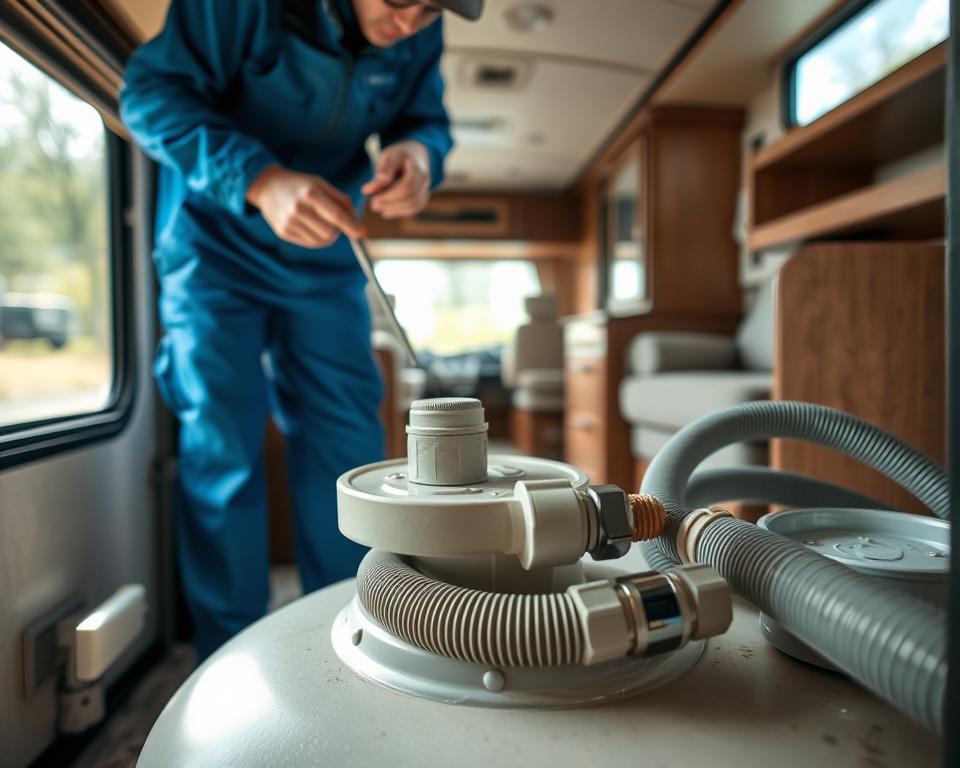Recreational Vehicle Tank Emptying Handbook: Service Your System
Curious about what happens if you ignore your motorhome’s tank pumping needs? Inadequate waste management can severely impact your enjoyment and safety while traveling. Foul odors and expensive repairs are just the start. Adequate sanitation system upkeep is vital for any RV owner. Regular RV tank pumping and wise practices can avoid catastrophes during your trips. This RV sewer pump guide will detail the significance of efficient waste removal and how to service your RV’s system perfectly.
Getting to Know Your RV Waste Setup
Your RV comes with a dedicated waste system for proper waste management while on the road. It consists of black tanks for sewage and gray tanks for sink and shower wastewater. Knowing how these tanks work is crucial for maintaining them properly.
Monitoring your RV’s waste system is essential to avoid clogs and backups. These disruptions can ruin your travels and create unhygienic conditions. Regularly monitoring black and gray tank levels helps keep optimal operation. This is crucial for cleanliness and preserving a healthy environment.
Correct dumping practices ensure your comfort and avoiding harm to the environment. Using your RV’s waste system correctly ensures waste is handled and disposed of effectively. Knowing the plumbing and disposal methods in your RV is important for seamless travel experiences.
The Value of Timely RV Tank Emptying
Regular pumping of your RV’s tank is key to a smooth-functioning waste system. Over time, solids build up, leading to bad smells and possible blockages. Such issues disrupt your travels. Timely tank pumping prevents these problems and dodges expensive repairs due to neglect. It’s vital for managing wastewater properly, ensuring compliant disposal.
Timely pumping wards off odors and extends the plumbing’s life. By sticking to a consistent pumping routine, RVers keep their vehicles in prime shape. This prevents stench and road trip troubles, underlining the value of regular maintenance.
| Benefits of Regular RV Tank Pumping | Consequences of Neglect |
|---|---|
| Curbs foul aromas | Worsening odors |
| Stops backups | Pump failures |
| Extends tank lifespan | High upkeep costs |
| Encourages eco-friendly disposal | Environmental hazards |
Knowing why to pump regularly optimizes your system. It ensures pleasurable journeys, letting you concentrate on adventures instead of waste management.
When to Empty Your RV Septic
How often to empty your septic tank matters for system health. Generally, the recommendation is every three to five days when in use. This interval may change depending on factors like tank size and number of occupants.
Smaller tanks or higher usage requires more frequent dumping. Watching your black tank’s levels is crucial for upkeep. Aim to pump when it’s about two-thirds full. This practice simplifies waste removal and helps avoid troublesome situations.
Regular black tank care prevents blockages and smells. Knowing capacity and monitoring fill level helps set the optimal schedule, tailored to your circumstances.
| Factor | Pumping Frequency |
|---|---|
| Light usage | 3–5 days |
| Higher Occupancy (3–5 people) | 2–4 days |
| Small Tank | As needed (often every 2 days) |
| Level-based pumping | At two-thirds capacity |
Optimal RV Tank Emptying Methods
A structured routine ensures clean tank dumping. Always begin with the black tank to ensure efficiency. This method reduces odors and guards against mixing with gray water.
Choosing a sturdy sewer hose designed for this task is crucial. It provides strength and flexibility, key for a clean process. Ensure all connections are tight to prevent leaks. After emptying, flush the tank well with water to remove residual waste and maintain cleanliness.
Do not keep the black tank valve open when hooked up at a full site. A closed valve allows solids to break down fully, avoiding blockages. Adhering to these practices ensures cleaner tanks and fewer foul odors.
| Key Steps | Details |
|---|---|
| Start with Black Tank | Black then gray for best flushing |
| Invest in Gear | Choose a durable sewer hose for efficient dumping |
| Rinse After Dumping | Perform a full flush to clear residual waste |
| Keep Valve Closed | Close valve to let solids liquefy |
How to Avoid Tank Smells and Blockages
To ensure your RV remains fresh, effective waste management is key. RV tank odors can ruin your trip fun. Using water correctly helps break down waste, avoiding clogs. Choosing RV-safe toilet paper is wise as it dissolves easier, reducing blockage risk.
Bio-enzyme additives accelerate waste breakdown and cut odors. Unobstructed vents is crucial for odor control and proper airflow. Frequent flushing after each use ensures tanks stay clean, avoiding aroma issues.
Proper dumping keeps lines clear, focusing on human waste and RV-approved items. Following these recommendations lets travelers maintain a hygienic environment for enjoyable journeys.
When to Get a Professional Pump-Out
Recognizing when to book a pro saves headaches. Act quickly if you notice slow drainage, lingering odors, or stubborn clogs. These signs indicate the system may need more than routine care.
Professional RV waste services offer thorough cleaning. Their technicians have specialized tools for clearing clogs and sanitizing tanks after emptying. This maintenance not only ensures cleanliness but also extends your system’s lifespan.
Watch for these indicators before you call a pro:
- Slow draining of tanks
- Persistent odors after emptying
- Leftover solids in tank
While regular upkeep is crucial, sometimes professional help is necessary. Timely expert intervention turns major headaches into manageable tasks.
Long-Term RV Septic Maintenance
Long-term RV care goes beyond frequent pumping. A thorough strategy is key to lasting performance and efficiency. Begin with regular deep-cleaning of tanks to prevent harmful buildup and future complications.
Regular inspection of dump valve seals prevents leaks and odors. Damaged seals can spoil your adventures. Catch problems early with routine checks to prevent costly repairs.
Monitoring tank sensors is crucial for accurate readings. Faulty sensors can give incorrect tank levels, risking overflows or unnecessary pump-outs. Inspect these components routinely to maintain system accuracy.
The following table outlines key long-term maintenance tasks and suggested intervals:
| Maintenance Task | Interval |
|---|---|
| Deep-Clean Tanks | Biannually |
| Check Valve Integrity | Every trip |
| Check Tank Sensors | Monthly |
| Sanitize System | Once a year |
Adhering to this plan saves time and money. Meticulous care ensures worry-free adventures without septic troubles.
Understanding Mobile RV Septic Service
On-location pumping offers ultimate convenience. It’s a boon for remote camping without dump stations. These services prioritize ease, ensuring sanitation without extra travel.
Eco-compliant pumping meets environmental standards. It assures proper disposal, saving time and keeping campsites clean and comfortable.
Understanding these benefits enhances trip planning. These services support sustainable camping by promoting responsible waste management. They blend ease with environmental responsibility.
To Summarize
Regular care of your RV’s tanks is critical for system longevity and efficiency. Timely pumping and understanding your waste setup are essential. These steps form the basis for a positive experience. A well-kept RV prevents odors and costly repairs.
Being proactive about waste management lets you focus on adventures. Regular upkeep or professional help ensures your comfort is maximized, making your trips effortless and memorable.
Knowing the right schedule and methods for tank pumping ensures perfect sanitation. With this knowledge, embark on new adventures confidently, knowing your RV is prepared for any experience.


